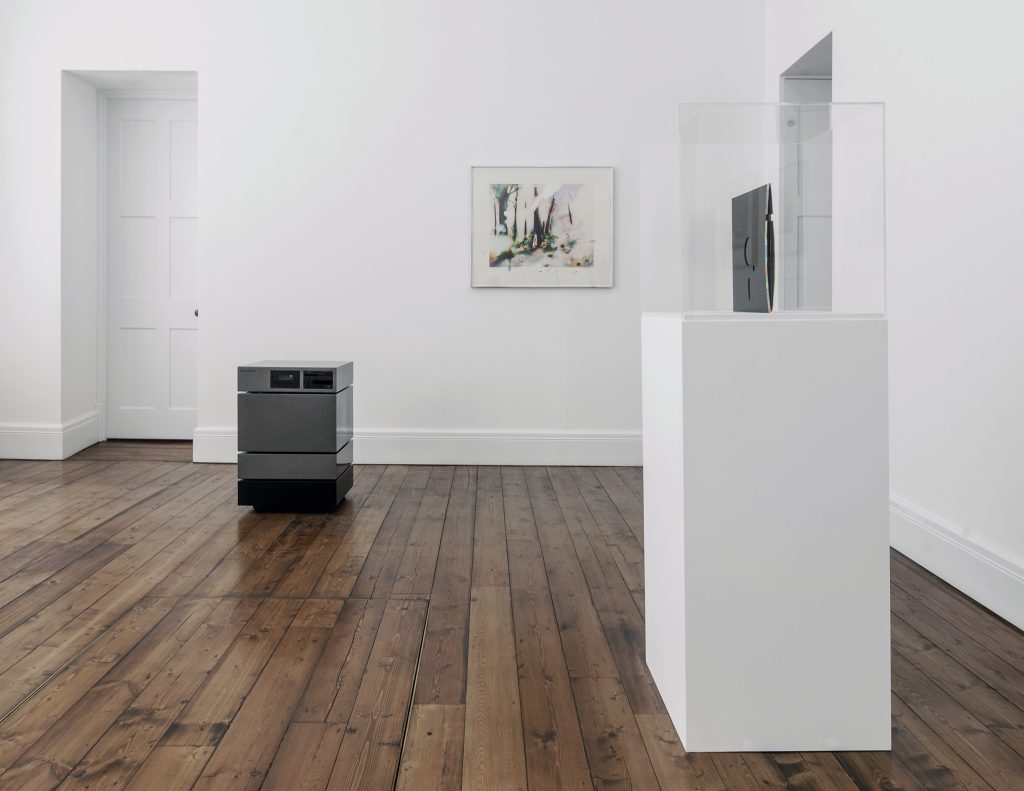
For the so-called young British artists, 1995 was, according to the writer Michael Bracewell, curator of ‘New Order: Art, Product, Image: 1976-1995’, what 1976 had been for London punk – a mythical Year Zero. Between these zeroes, British self-image and identity – and the ascendant ‘style wars’, as Peter York called them, later brilliantly theorised by Dick Hebdige – underwent an aesthetic revolution in the productive collapse of art into design, design into pop and pop into product.
This ‘New Order’ that Bracewell periodises is also an allusion to the Manchester post-punk band, an absent presence at the centre of the exhibition represented by Peter Saville’s sleeve design for the biggest-selling 12″ single of all time, ‘Blue Monday’ of 1983 on Factory Records. Instead of punk’s cut-and-paste anti-aesthetic, Saville, who trained as a graphic designer and cofounded Factory in 1978, elected ultra-elegant industrial modernism, by turns funerary and melodramatic, from record sleeves to music videos, club interiors to Christmas cards.
At Sprüth Magers, by encasing ‘Blue Monday’ in a vitrine near Damien Hirst’s Satellite, 1989-2010, a wall-mounted display of pharmaceutical packaging, the works touch at a distance, in a maudlin sort of way, creating an equivalence that repeats the latter’s famous museological gesture, elevating – perversely – this most ubiquitous product. Elsewhere, Bracewell has written at length (‘Peter Saville: Estate 1978-2007’ provides the thesis expanded in this exhibition) on the significance for Saville of encountering Richard Hamilton’s work Toaster, 1966-67, and realising that, in the space between functionality and non-functionality, design ‘could be liberated from the containers of product, brief and market and be allowed to exist as an unfettered artistic form’. Alternatively, this ‘New Order’ might prosaically be called ‘postmodernism’, recalling the V&A’s poignant final gallery of ‘Postmodernism: Style and Subversion 1970-1990’ exhibition in 2011 featuring Robert Longo’s ‘Blue Monday’ music video framed as a lament for the passing of ‘critical postmodernism’: ‘Why can’t we be ourselves like we were yesterday / I’m not sure what this could mean / I don’t think you’re what you seem’.
In the space between Hirst and Saville, Hamilton the elder is represented here not by a version of Toaster, among his most celebrated works, but by four prints dating from 1976-1980 alongside The Diab DS-101 computer. Fully functional (the inputs on the reverse bear embossed labels, ‘RICH’ and ‘RITA’, the artist Rita Donagh, also Hamilton’s widow), the computer was designed with Ohio Scientific from 1985 to 1989 and exhibited as a work in itself.
The earlier of the two prints are, similarly, the result of a collaboration with an electronics manufacturer, ‘studies’ of a hi-fi design realised with the Japanese company Lux in 1979. As Hamilton saw parity between art, design and technology, every Factory product purchased by pop consumers could also be an art object in its own right. ‘For Saville,’ Bracewell has written, ‘this would connect his experience as a consumer of pop – and the classic notion of pop creating its own heightened world – with his interest in Modernism and Pop Art as a philosophy of ideas.’
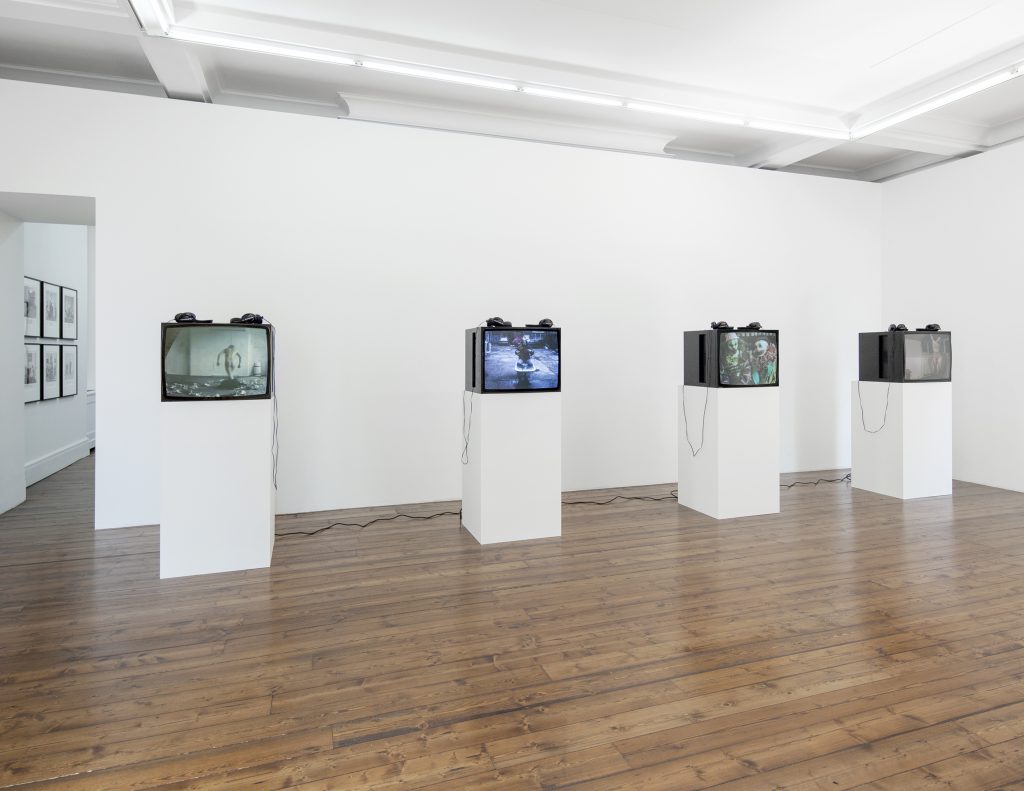
Downstairs, in the gallery’s ground-floor window, staring down Grafton Street, a totemic quartet of Sony Cubes atop white plinths loop Betamax videos of and by Angus Fairhurst, A Cheap and Ill-Fitting Gorilla Suit, 1995, Gary Hume, Me As King Cnut, 1993, Damien Hirst with Fairhurst, A Couple of Cannibals Eating a Clown (I Should Co-Co), 1993, and Sam Taylor-Johnson, Brontosaurus, 1995, Gillian Wearing is Dancing in Peckham, 1994, in the basement. Deadpan, insouciant, abject, these ‘Beckett-like videos’, as the press release characterises them, demonstrate ‘a desire to break out, break away and declare a new freedom … In the lineage of Punk they make use of friends, cheap technology and seemingly non-descript space to become themselves’ (not ostensibly of Taylor-Johnson, Brontosaurus is the odd one out here).
If the punk youthquake – its fissile Luddism, carnivalesque prankery and parodic delinquency – cleared space for new identities to emerge then the yBa’s post-Year Zero legacy is much more ambivalent. Unproblematically linking punk to the yBas, Bracewell reiterates Neville Wakefield’s art-critical PR line for ‘Brilliant! New Art From London’, which opened at the Walker Art Centre in 1995. For these artists, Wakefield claimed, ‘parodic indifference and irony … have become less a question of practice than the underwriting of a sensibility’. Turning boredom into action and provocation, ‘the current generation is dismissive of the ideologically rigorous but aesthetically anaemic art leavened throughout the 1980s on the imported yeast of post-structuralism and the essentially foreign theory enlisted for its legitimisation’.
Deadpannery, insouciance and abjection was a response to academic post-structuralism’s ossified mannerism. If the latter in its ‘critical’ phase had provided the tools of identity politics, where identity reemerges in the 1990s it is narrowly defined – youthful, soft chauvinist, white, Soho-centric. The New Order was a New Labour vision for a young country called New Britain built on individualism, competition and materialism. Manic neophilia – which today characterises the contemporary art market – became the cultural powerhouse of economic post-industrialism.
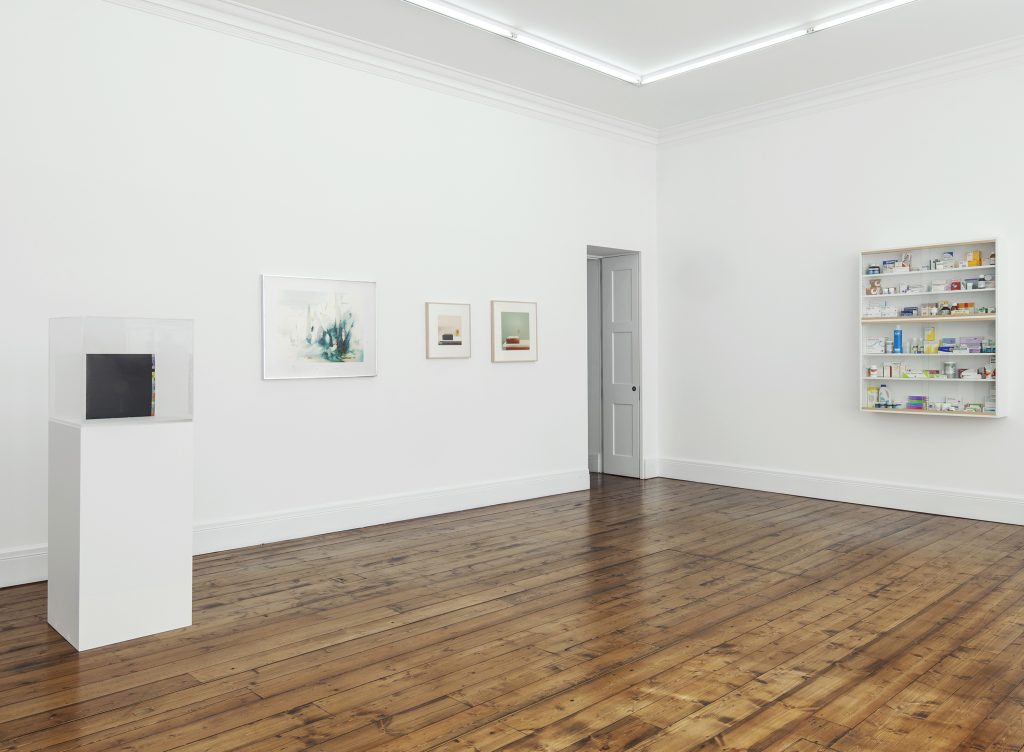
Writing in everything magazine in 1995, John Roberts sought to reframe the supposedly anti-intellectual position as wilful ‘philistinism’, citing, specifically, the collective BANK whose artist-led exhibitions and spaces represented one alternative to yBadom of the time. In 1995, at the brink of the New Order, BANK staged ‘Zombie Golf’, a movie-set populated not just by the work of nine artists but a squad of the living dead, tearing each other apart, bloodied and disembowelled among the art. Certainly BANK’s refusal to separate common culture from art’s experience was characteristic of the yBas at the time, but instead of an ironic sensibility – BANK resolutely denied they were being ironic – their strategic philistinism was what Roberts called a ‘discursive construction’ that shifted positions pending on what constituted ‘proper’ or ‘correct’ aesthetic behaviour. Likewise, in the context of the emergent curatorial class, for ‘proper’ or ‘correct’ professionalisation.
While MOT International presented a BANK survey in 2013, ‘Summa’ at Piper Keys is the first ‘solo presentation’ of BANK since their last collective works in 2002, which comprised collaboratively produced paintings. Piper Keys, an artist-led space hosted inside what was formerly Raven Row, a space that might otherwise have programmed such a show, combines a series of five of these collaborative paintings titled ‘Field of Dreams’ with a selection of Giclée and Xeroxed public information sheets, posters and ‘THE BANK’ newspaper front pages, dating from 1996-99.
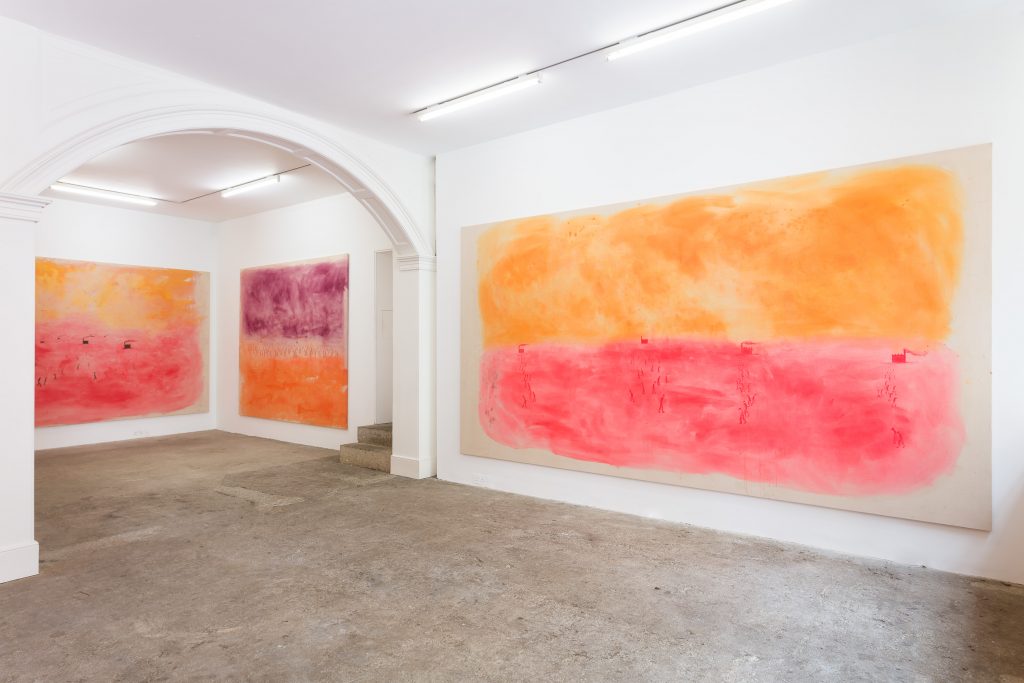
First exhibited in ’99 at EASTinternational in Norwich, part of the curator Lynda Morris’s ‘International Provincial’ programme, the paintings consist of patterned ‘matchstick’ Lowry figures receding into bathymetric Rothko colour fields – a stand-off between provincial popular modernism and cosmopolitan avant-gardism. In the foyer of Piper Keys, two of the original accompanying posters appear, one caricaturing the London/provincial divide and the other, a mock-questionnaire surveying ‘Conscience in Art’, begins with the question, ‘Did you attend a fee paying school?’ Strikingly, nearby posters anticipate and testify to the depressing status quo. ‘Say NO to craft’ speaks to the Aaron Angell years. ‘CHISENHALE WHY?’ the power of the biennial-induction machine. ‘Galleries all owned by rich people’ the squeezing of artist-led activity out of the city.
Unlike the majority of BANK exhibitions, ‘SUMMA’ doesn’t assemble a context for exhibiting the work of others (in creating a context for their work, BANK’s group shows also produced a parallel mapping of contemporary art activity in London). At Piper Keys, the ‘Field of Dreams’ paintings – isolated from the usual cacophony – look surprisingly tasteful, market-ready. And quite rightly BANK suggests in the press release that ‘it’s about time these works were bought by a public collection like the Tate or Arts Council’ – where currently not even one of their works is represented.
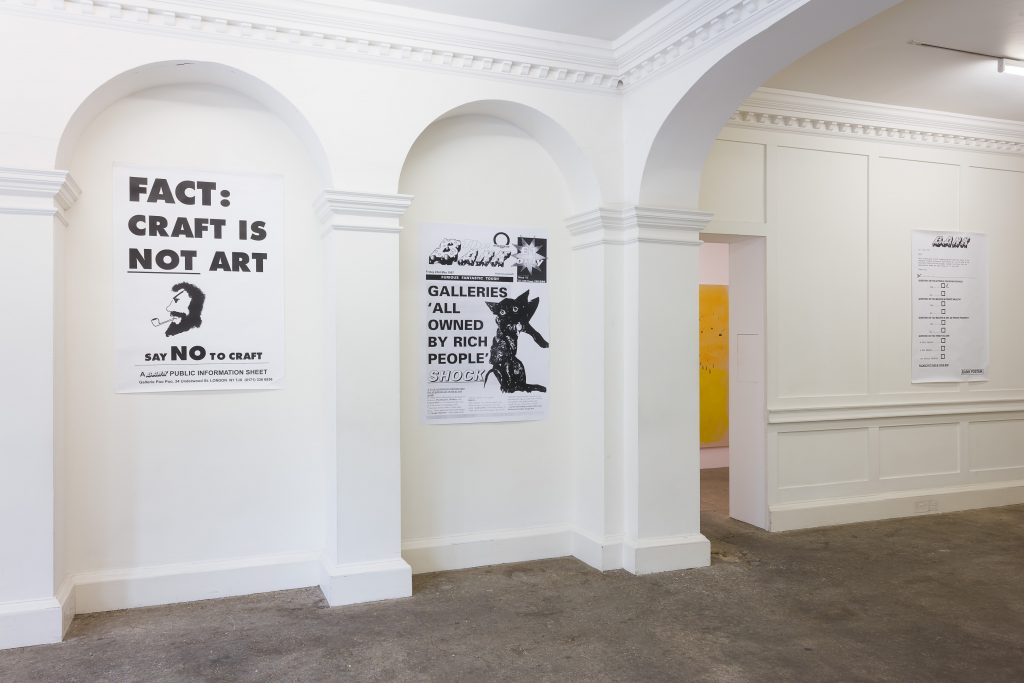
BANK has talked about the way that their rejection of what they saw as the ‘luvviness’ of contemporary art’s sociality – even more so today is sociality the lubricant of contemporary art – became a part of their self-identity, believing, rather naively, that ‘good work spoke for itself’. Though a compelling thesis, ‘New Order’ as an exhibition is at best schematic and deserves to be opened up outside of the spaces of a commercial gallery. As such, it would disengage from the spell of public relations popular culture and instead of reinvesting the myth of yBa at this moment of nineties revivalism consider, for example, the legacy of BANK – self-organised group shows that auto-generate contexts and social networks counter to the popular view of yBa London, the significance of the private view over the show itself, collective working, artistic control of the presentation of art – and the many other artists who either were not given the space to become themselves or did not want to.
Listen to me discuss these exhibitions on the Art Monthly Talk Show, Resonance FM, along with guests Louisa Lee and Laura Harris, and presented Matt Hale.
